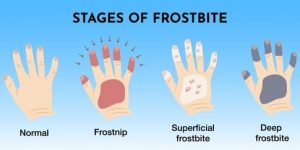Table of Contents
What is frostbite?

Frostbite or chilblain is an injury to the body that is caused by freezing. It most often affects the nose, ears, cheeks, chin, fingers, or toes. It can permanently damage the body,. In severe cases, it can lead to amputation.
Limited studies have reported an association between frostbite and the development of non-melanoma skin cancer.
How bad is my frostbite?
Frostbite occurs in several stages:
- Frostnip: It is a mild form of frostbite that causes skin irritation. Continued cold exposure leads to numbness, pain and tingling. Mild frostnip doesn’t cause permanent skin damage. Most of the times it can be treated at home (visit the section below).
- Superficial (moderate) frostbite: It causes slight changes in skin color. The skin may appear warm and patchy. The surface of the skin has irregular colors due to lack of blood flow to the skin. You may notice stinging, burning and swelling. A fluid-filled blister may appear 12 to 36 hours after rewarming the skin (soaking the affected area in warm for 15-20 minutes). It requires medical treatment under your doctor’s supervision.
- Deep (severe) frostbite: It affects all the layers of the skin as well as the tissues that lie below. The skin turns white or blue-gray. You may lose all sensation of cold, pain or discomfort in the area. Joints or muscles may stop working. Large blisters may form 24 to 48 hours after rewarming. The tissue turns black and hard as it dies. It requires immediate treatment under your doctor’s supervision.
How to manage mild frostbite?
Keep track of your symptoms using Ankr (myAnkr web portal or the Ankr app). It will help you describe the discomfort to your doctor or nurse.
- Move into a warm room as soon as possible.
- Do not walk on frostbitten feet or toes. Walking increases the damage.
- Put the affected area in warm water.
- You can also warm the affected area using body heat. For example, use your armpit to warm frostbitten fingers.
- Don’t rub the frostbitten area with snow or massage it at all. This can cause more damage.
- Don’t use a heating pad, heat lamp, or the heat of a stove, fireplace, or radiator for warming.
- Dress in several layers of loose, warm clothing.
- Wear a hat or headband that fully covers the ears. Choose heavy woolen or windproof materials for cold protection.
- Wear mittens rather than gloves for better protection.
- Wear socks and sock liners that fit well, wick moisture and provide insulation.
- Eat well-balanced meals and stay hydrated.
How to manage moderate to severe frostbite?
Seek medical attention if you experience:
- Signs and symptoms of superficial or deep frostbite
- Increased pain, swelling, inflammation or discharge in the area that was frostbitten
- Fever
- New, unexplained symptoms
- Hard, cold, blotchy skin.
- Hypothermia
What causes frostbite?
It occurs when the skin and underlying tissues freeze. The most common cause is exposure to cold-weather conditions. But it can also be caused by direct contact with ice, freezing metals, or very cold liquids.
Specific conditions that lead to frostbite include:
- Wearing clothing that isn’t suitable for the conditions you’re in — for example, it doesn’t protect against cold, windy or wet weather or it’s too tight.
- Staying out in the cold and wind too long. Risk increases as air temperature falls below 5 F (minus 15 C), even with low wind speeds. In wind chill of minus 16.6 F (minus 27 C), frostbite can occur on exposed skin in less than 30 minutes.
